We're always so happy to present an authentic take on our tours. Today we feature Dale of the Maritime Explorer and his wise words and wonderful photos from our Mexican Day of the Dead tour.
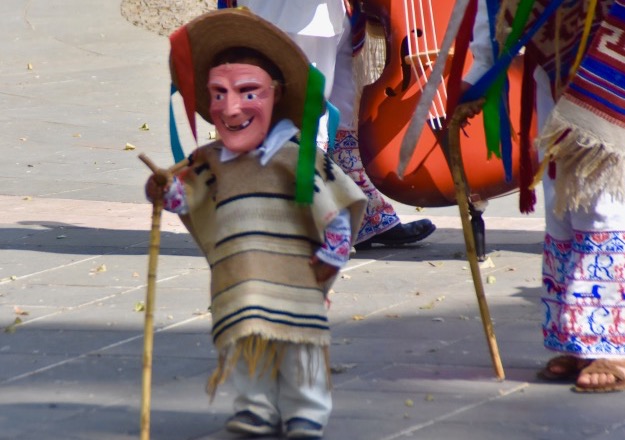
We are coming to the end of the second week of what has so far been an amazing historical, cultural and gastronomical tour through central Mexico with Adventures Abroad’s veteran guide Victor Romagnoli. Today we left the city of Guanajuato which I described in my last post as the most unexpected and pleasant surprise of the trip.
We are headed due south to the state of Michoacan which has a number of must see attractions including the capital city Morelia, a UNESCO World Heritage Site, the ruins of the pre-Columbian city of Tzintzuntzan and the small city of Patzcuaro where, if we are lucky, we might see a performance by a troupe of viejitos. I hope you’ll join us.
Michoacan
Mexico has thirty-two states in all and it seems like we have been in most of them on this trip, but Michoacan is actually only about the eighth by my count. As far as Mexican states go it is just about in the middle at 16th in size with a population of just over four million.
The name comes from the Nahuatl and means ‘place of the fishermen’ which you would think on glancing at a map of Mexico would be a reference to the Pacific coast on which Michoacan abuts. That would be wrong. It refers instead to the once thriving freshwater fishery on Lake Pátzcuaro and other lakes in the area which are quite unique.
They are endorheic, which means they are not drained by rivers that eventually lead to the ocean. Rather they are in a large basin surrounded by volcanoes and are quite shallow. On our way south from Guanajuato we drove across a causeway that cuts across the second largest lake in Mexico, Lago de Cuitzeo.
This is a photo I found on the web which shows this most un-Mexican like landscape. By that I mean that it’s not what most tourists would bring to mind when thinking about Mexican environments. One of the great things about travel is that it helps dispel stereotypes and replaces them with the realities of situation on the ground, almost always I have found, for the better.
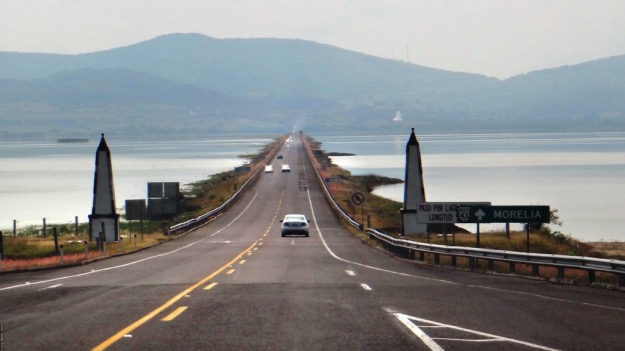 Lago de Cuitzeo
Lago de Cuitzeo
The lakes of Michoacan were surrounded by marshes that were absolutely loaded with waterfowl and shorebirds of at least a couple dozen species I recognized as we whizzed by in our bus. The hills surrounding the lakes were covered with pine-oak forests while the lower regions were given over to maize and cotton fields as well as pastureland. Quite simply, Michoacan is a beautiful state and presents a side of Mexico I didn’t know existed.
Not surprisingly, the fecundity of the region has long made it a region favoured by various groups that have been migrating to the area over the last 10,000 years. In the immediate centuries before the arrival of the Spanish the area was under the control of the Purépecha peoples who presided over what is generally referred to as the Tarascan Empire with its capitol at the city of Tzintzuntzan which we will visit during our time in Michoacan.
This empire was second in size and power only to the Aztecs, who had tried and failed to conquer them in the years preceding Cortés arrival in 1519. Because of the bad blood between the two groups, the Purépecha refused to assist the Aztecs when attacked by the Spanish and after learning what had happened to the mighty Aztec empire, King Tangaxuan II pledged allegiance to the invaders without a fight. Unfortunately as so often seems to have been the case with the Spanish conquistadors, that didn’t settle matters.
In 1530, a former body guard of Charles V of Spain, Nuño de Guzmán literally went on a rampage in parts of Mexico including Michoacan. Despite being welcomed by King Tangaxuen II, Guzmán had him tortured and burnt alive along with almost every other Tarascan native he could lay hands on.
It was hard to believe anyone could be worse than Cortés, but Guzmán holds the title as the most barbaric conquistador in Mexico. He was so bad that eventually even his fellow Spaniards were sickened by his excesses and had him charged with treason and shipped back to Spain in shackles. But as with many other conquistadors who had acted disgracefully he wheedled his way back into favour and returned to his body guard duties until his death in 1561.
So the history of post-Columbian Michoacan is a bloody one, like most of central Mexico, but the violence didn’t end there. Mexican revolutionary leader Miguel Hidalgo y Costilla whom we first encountered in Guanajuato, was educated at the university in Morelia and later taught his progressive ideas there until he was sacked in 1792.
Much of the War of Independence was fought in Michoacan state with Valladolid, now Morelia, being one of the first cities to fall to Hidalgo’s army. It was from here that Hidalgo began his failed march on Mexico City and the greatest number of his troops were from Michoacan. After his death, Michoacan native José María Morelos became the de facto leader of the independence movement and despite being a priest, was an extremely effective military leader, winning battle after battle until he too was captured and executed in 1815. The city he was born in, Valladolid, was renamed Morelia after independence.
However, all is not bloodlust and savagery in the state of Michoacan. It is also home to the world famous Monarch Butterfly Biosphere Reserve whereby almost the entire population of eastern monarch butterflies migrates to the pine forests of Michoacan where they mass together by the millions to wait out the winter. We are just a bit early to see them, but that gives a good reason to return to this beautiful landscape.
Morelia, Michoacan
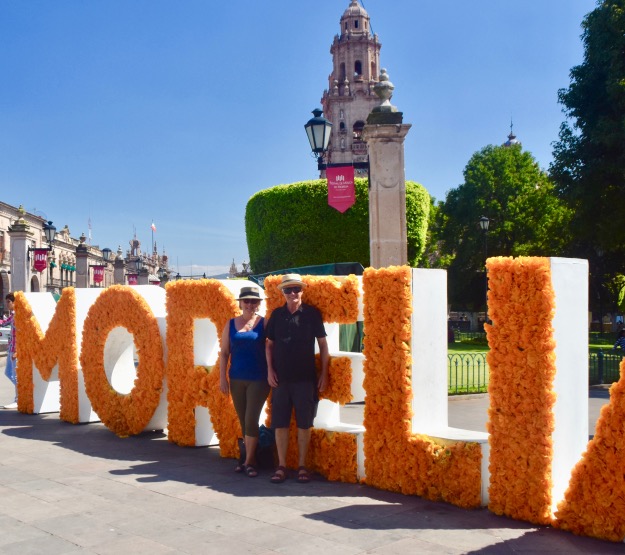 In Morelia
In Morelia
Morelia is yet another of Mexico’s fabled colonial cities that has attained UNESCO World Heritage Site status for this reason:
Built in the 16th century, Morelia is an outstanding example of urban planning which combines the ideas of the Spanish Renaissance with the Mesoamerican experience. Well-adapted to the slopes of the hill site, its streets still follow the original layout.
More than 200 historic buildings, all in the region’s characteristic pink stone, reflect the town’s architectural history, revealing a masterly and eclectic blend of the medieval spirit with Renaissance, Baroque and neoclassical elements. Morelia was the birthplace of several important personalities of independent Mexico and has played a major role in the country’s history.
As we enter the city, it is readily apparent that it is unlike any of the other colonial cities we have visited on this tour such as Oaxaca, Puebla, San Miguel de Allende or Guanajuato. The pink stone referenced in the UNESCO designation gives the city a unique look, particularly in the larger buildings like the cathedral and many churches. What is notably absent is the presence of any modern looking buildings in the compact core of the city which would detract from the city’s obvious charm.
Our hotel, the Mision Catedral is almost directly across the street from the Plaza De Armas and not far from the cathedral. It and many of the other buildings along the main street have colonnades where customers at the cafes and bars that occupy them are sheltered from the searing sun.
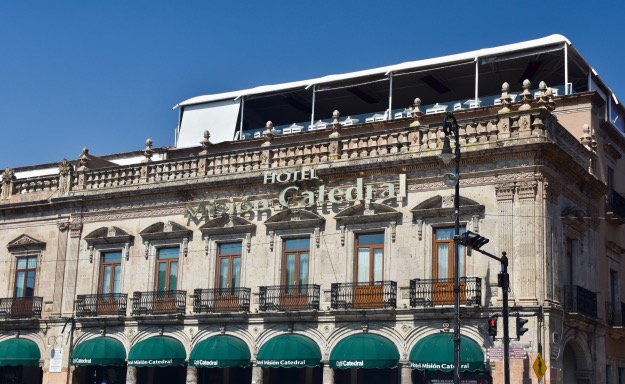 Hotel Mision Catedral
Hotel Mision Catedral
After a pleasant lunch at one of these cafes we meet our local guide for a quick tour of central Morelia starting with the cathedral which is the seat of an archbishopric. It was started way back in 1660, but not completed until 1744. Many people think it is the finest cathedral in Mexico and I’d be hard pressed to disagree. It’s certainly far better looking than the pile that is the Metropolitan cathedral in Mexico City.
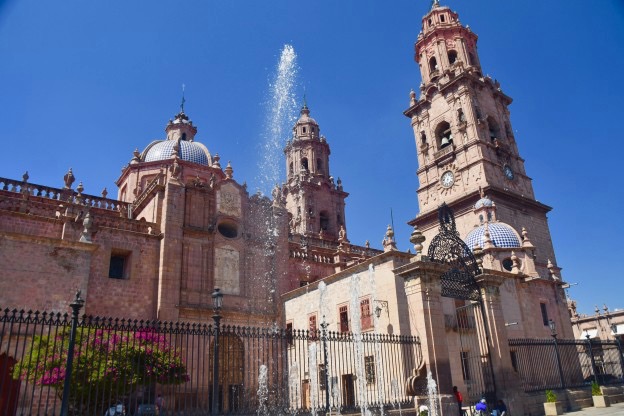 Morelia Cathedral
Morelia Cathedral
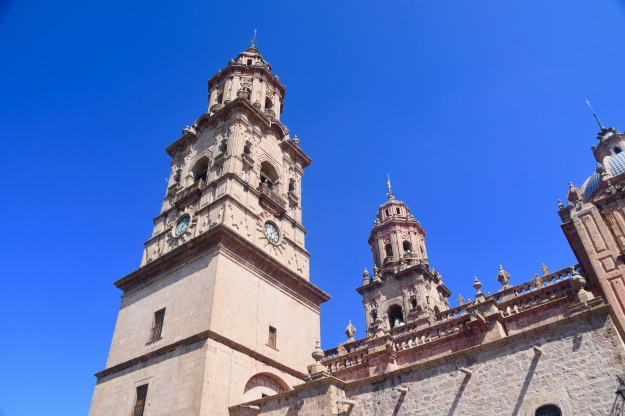 Cathedral Bell Towers
Cathedral Bell Towers
The side entrance best illustrates the pinkness of the local stone used to construct this and over 200 other buildings in Morelia.
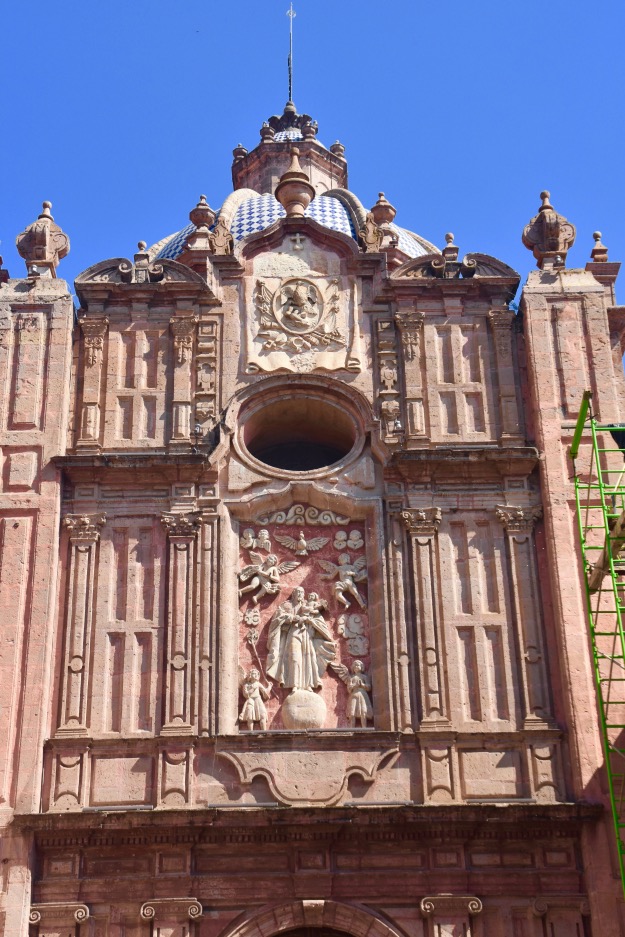 Cathedral Side Entrance
Cathedral Side Entrance
After the obligatory tour of the overly ornate interior with the usual over the top altar, this one in silver, not gold, we move on to something that holds more interest for me, the Casa Natal de Morelos where Morelos was born and lived much of his life. It’s obvious from the outside that Morelos did not spring from poverty and is a reminder that many of the Mexican revolutionaries were educated upper middle class folk inspired by the ideals of the American and French revolutions.
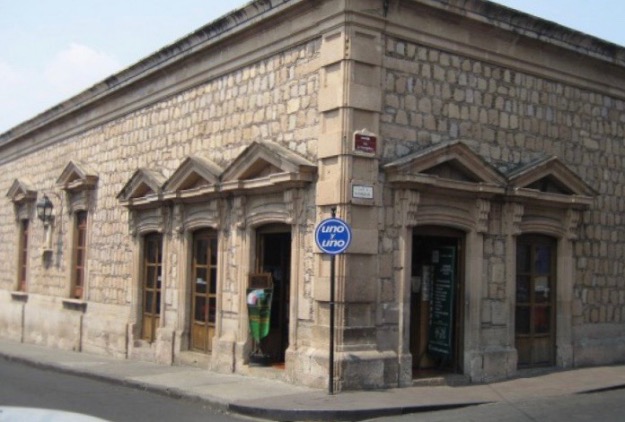 Casa Natal de Morelos
Casa Natal de Morelos
Inside there is this painting of the famed meeting between Hidalgo and Morelos wherein Hidalgo asked Morelos to found an army which he did, ultimately with a lot more success than Hidalgo. By now I’m getting used to the iconography of Mexican revolutionaries. Hidalgo is always portrayed as bald on top with long flowing grey hair on the sides while Morelos inevitably wears a bandana.
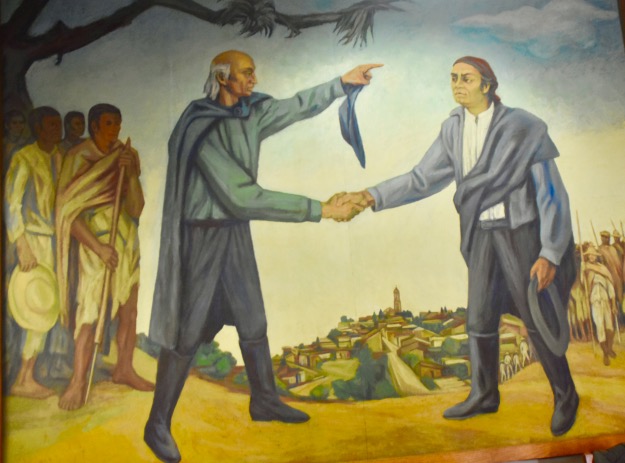 Hidalgo & Morelos Meet
Hidalgo & Morelos Meet
Next we walked a few blocks to the Michoacana University of San Nicolás de Hidalgo which has origins going all the way back to 1540, some ninety-four years before Harvard. Once again our friend Hidalgo was on site to greet us. It is apparent that Mexicans have great reverence for this man who is often considered the father of his country as George Washington is to Americans. I can only shake my head at how some Canadians have gone so far off the rails that they want to treat our similar figure, Sir John A. MacDonald as a war criminal.
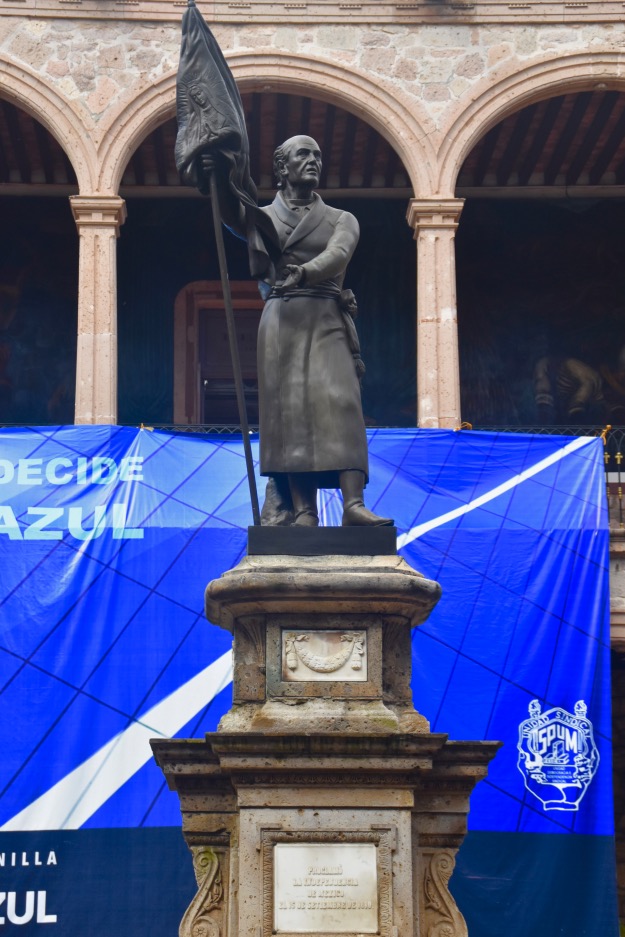 Hidalgo at University of San Nicolas
Hidalgo at University of San Nicolas
Also part of the museum is the library, which has a gorgeous almost all wooden interior which reminded me of a scaled down version of the one at Trinity University in Dublin. I found this small mural of particular interest as it shows examples of the five original written languages, of which the only one that originated in the New World was Mayan.
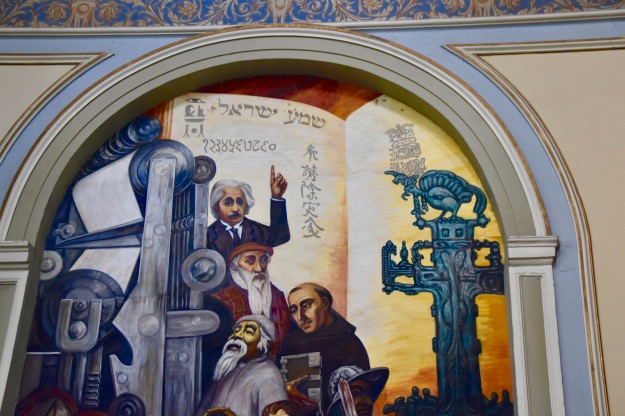 The Five Written Languages
The Five Written Languages
After the walking tour we had some free time and spend some it just enjoying the greenery and fountains in the Plaza de Armas.
That night during our group meal in a restaurant next to the hotel we heard what sounded like gunshots, but people weren’t running away so we followed Victor out to the street where a great display of fireworks was just beginning. The occasion was the lighting up of the cathedral to mark the beginning of the Christmas holiday season.
Starting from the bottom, the lights came on in intervals going higher and higher with each one while the crowds cheered louder and louder the higher the lights went until with a rousing barrage of fireworks the top of the bell towers were reached. It was a pretty neat example of stumbling across a local custom without any advance knowledge or planning.
Tzintzuntzan
Tzintzuntzan was the major city of the Tarascan Empire and of all the pre-Columbian sites we visited on this tour, by far the youngest, being founded only in about 1450. The name means ‘place of the hummingbirds’ and is actually a form of onomatopoeia whereby the words sounds like the thing it is describing e.g. sizzle or gurgle.
If you say Tzintzuntzan quickly it does sound like the whirring of a hummingbird’s wings. It has a nice location on a hill overlooking Lake Patzcuaro and apparently did stretch all the way down to the lake by the time the Spanish arrived in the 1522. At that time it was estimated that there were around 25,000 inhabitants.
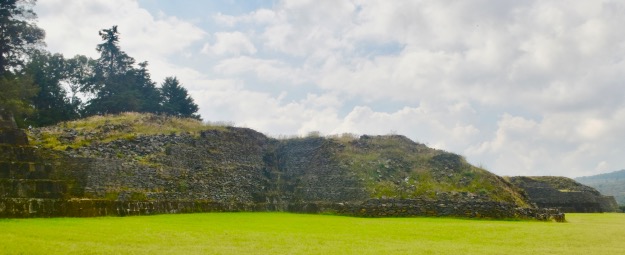 Tzintzuntzan
Tzintzuntzan
Today Tzintzuntzan is a largely forgotten place that gets a fraction of the visitors more prominent pre-Columbian sites like Teotihuacan get. There’s a pretty good reason for that – Tzintzuntzan is just not that interesting. At one time it was noted for its circular pyramids or yácatas, but the Spanish did such a number on them that today it is hard to discern what they must have looked like when they were fully intact.
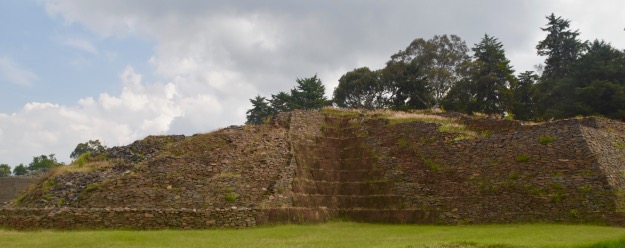 Ruined Yacata
Ruined Yacata
This photo does show the curvature of the yacata walls which were visible from all the communities around Lake Patzcuaro and atop which beacon fires were lit and could be used to transmit messages to the people below, much like western tribes used smoke signals.
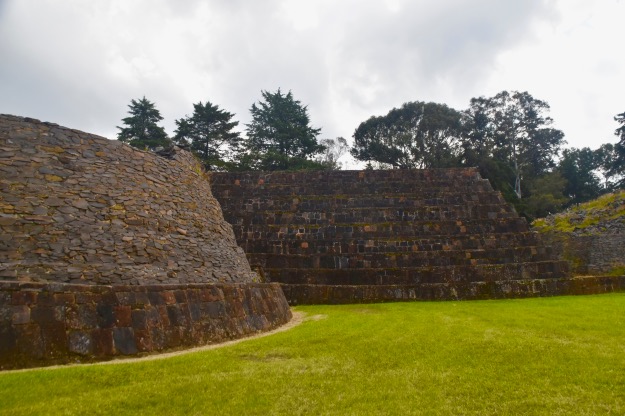 Circular Walls
Circular Walls
One of the reasons Tzintzuntzan has not been restored to any great extent is evident from this photo. It shows one of the few places where the original stone cladding of the yacata is still in place. If you want to see what’s left of Tzintzuntzan you need to go to Patzcuaro and other nearby colonial towns which basically stripped the walls of this place to build the churches and other monuments of those towns.
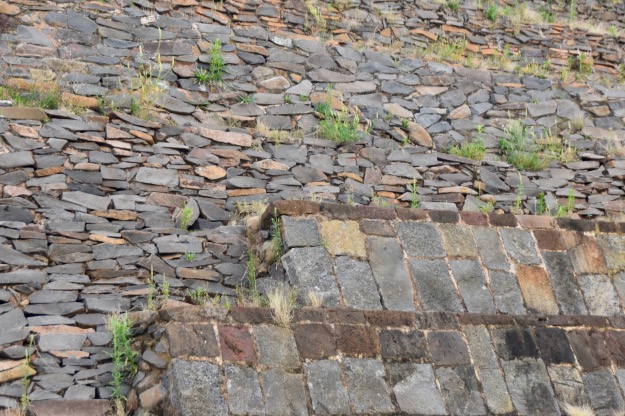 Stripped Walls
Stripped Walls
We left Tzintzuntzan to the vigilant ground squirrels that are all over the place and gave us their version of the raspberry as we made our way back to the bus.
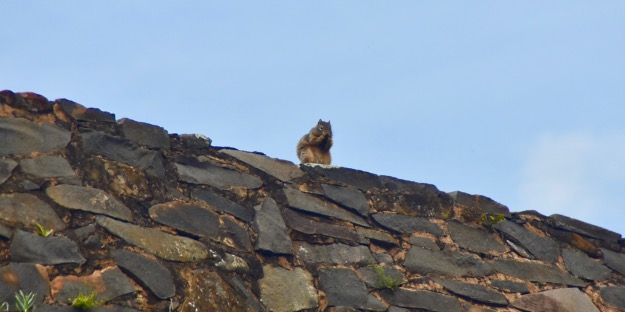 Vigilant Ground Squirrel
Vigilant Ground Squirrel
At the exit the Day of the Dead altar was still in place, although the flowers were beginning to fade. That seemed an appropriate Tzintzuntzan metaphor.
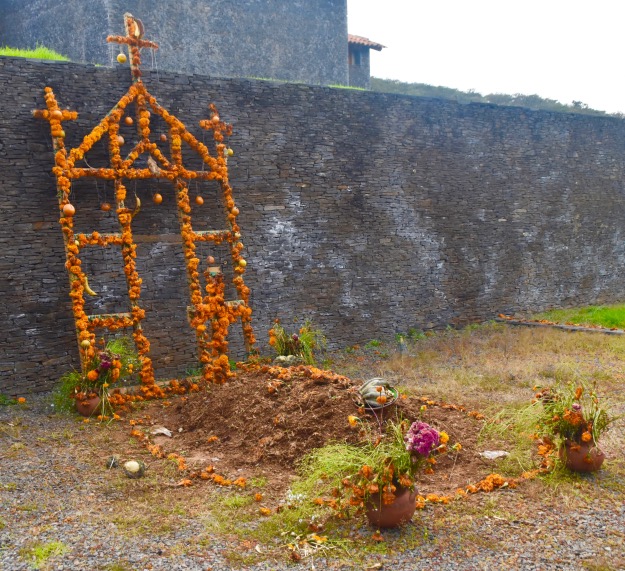 Tzintzuntzan Day of the Dead Altar
Tzintzuntzan Day of the Dead Altar
Patzcuaro
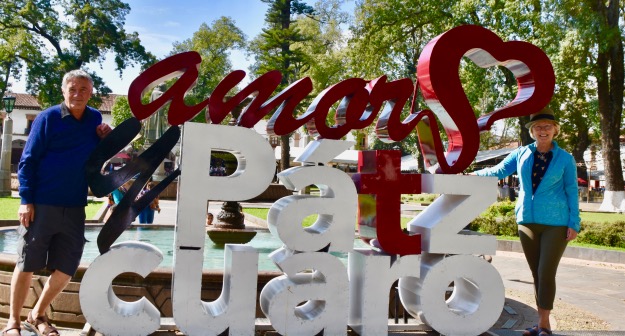 In Patzcuaro
In Patzcuaro
If Tzintzuntzan was a bit of a downer, the town of Patzcuaro was the perfect antidote, in fact one of my favourite places on the entire trip. Founded by the Purépecha people in the 1320’s, the original city, which had been supplanted by Tzintzuntzan as the principal Tarascan settlement, was depopulated by Nuño de Guzmán in 1526.
Patzcuaro was largely rebuilt from scratch starting in 1540 and has a distinct white and red coloured adobe architecture that has made it one of Mexico’s Pueblos Mágico or Magic Towns. There are 111 of these in Mexico and Patzcuaro is the third we have visited on this tour, Cholula and Teotihuacan being the other two. That leaves 108 reasons to return, because these places really are magical in every sense of the word.
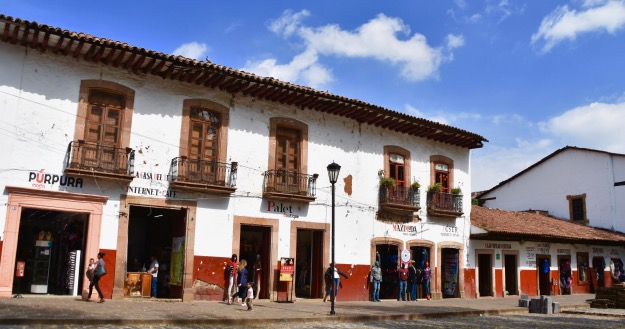 Patzcuaro Red & White Architecture
Patzcuaro Red & White Architecture
Our first stop, as it usually is, is at the town’s principal church, the Basilica de Nuestra Señora de la Salud which translates to the Basilica of the Virgin of Health. Unusual for Spanish colonial towns, the basilica is not on the town’s zocalo or public square, but rather on top of a small hill on the edge of town. The same as they did at Cholula, the Spaniards built the church on top of what was a Tarascan pyramid effectively and symbolically crushing the old religion with the new.
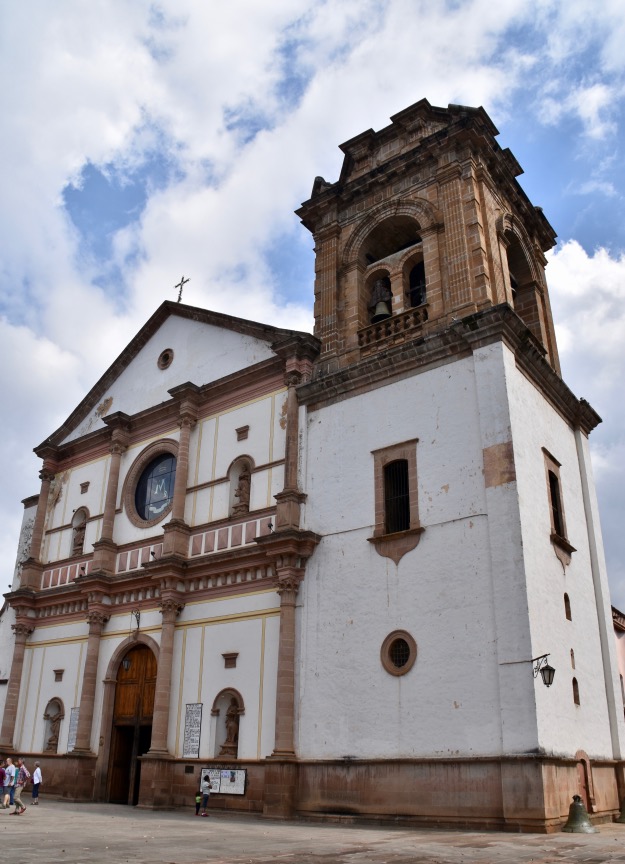 Church on the Pyramid - Basílica de Nuestra Señora de la Salud
Church on the Pyramid - Basílica de Nuestra Señora de la Salud
There was a mass going on inside, but I did duck in long enough to ascertain that this was one of the more restrained of the Mexican baroque churches and I was actually quite impressed.
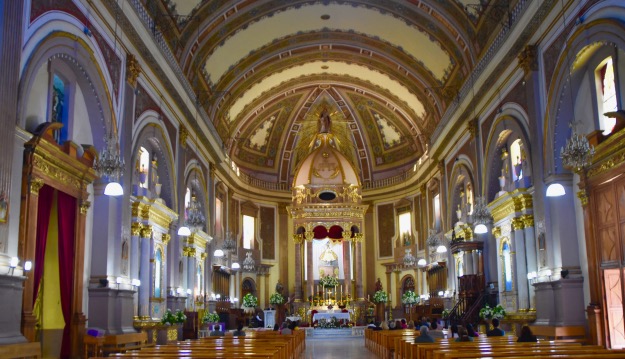 Church Interior - Basílica de Nuestra Señora de la Salud
Church Interior - Basílica de Nuestra Señora de la Salud
Patzcuaro is renowned for its craftspeople and that was apparent as we made our way from the church to the centre of town. There were dozens of stalls set up just outside the church and a good many stores in town selling all manner of things, particularly clothing. It was apparent that the target market was not tourists, but locals, although any one of these dresses would make a great present to take back to a granddaughter or niece.
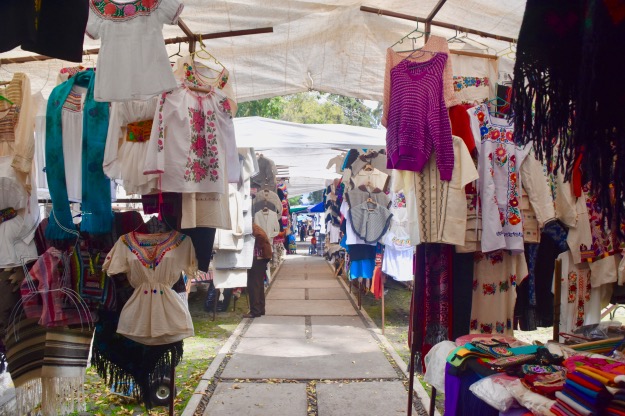 Patzcuaro Clothing for Sale
Patzcuaro Clothing for Sale
Patzcuaro has a lovely Plaza Grande which is very large for such a small town and I couldn’t help but notice this municipal worker clearing the leaves away with this broom made from a palm frond. I think the person who invented the leaf blower deserves a special place in Dante’s Nine Circles of Hell. Doesn’t this make a lot more sense from both an acoustic and environmental point of view?
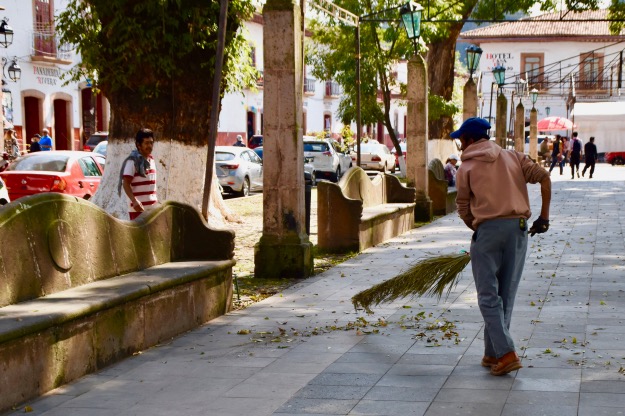 Natural Street Sweeper
Natural Street Sweeper
Gertrudis Bocanegra was a heroine of the Mexican War of Independence who was shot in Patzcuaro in 1817 at this very spot while tied to this very tree. She was so revered that the town has erected a canvas to protect the long dead tree from further decaying although it looks like a losing battle.
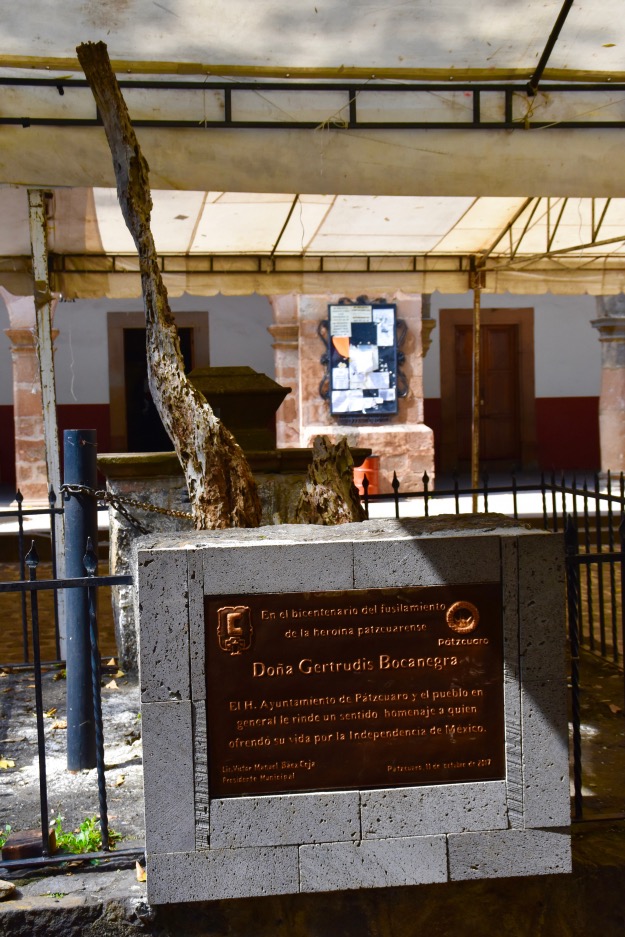 Gertrudis Bocanegra Tree
Gertrudis Bocanegra Tree
It was now time for a late lunch at one of the many restaurants around the Plaza Grande and Alison and I and my sister Anne chose the one that seemed to have the most local patrons. As Patzcuaro is not really a tourist town, except perhaps to other Mexicans, the menu was entirely in Spanish and didn’t seem to have any of the usual Mexican dishes found in the bigger cities.
The waiter spoke no English and Victor was otherwise occupied or we would have asked for his advice. So we just said ‘To hell with it” and pointed to a couple of places on the menu and nodded. This is what we got.
This is smoked pepper with fried minnows which you eat whole and try to ignore those little eyes staring accusingly at you. Actually, really, really good.
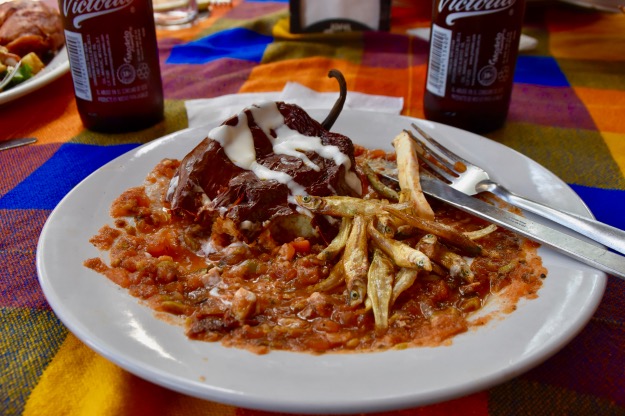 Smoked Pepper and Minnows
Smoked Pepper and Minnows
This is a more conventional smoked pepper stuffed with corn bread. Smoked peppers are a Patzcuaro specialty and always having been a fan of stuffed peppers, I thought we did pretty good on the blind faith ordering system. Having a couple of cold Victoria’s to wash them down with didn’t hurt either. In fact, I can’t imagine not drinking beer with this kind of food.
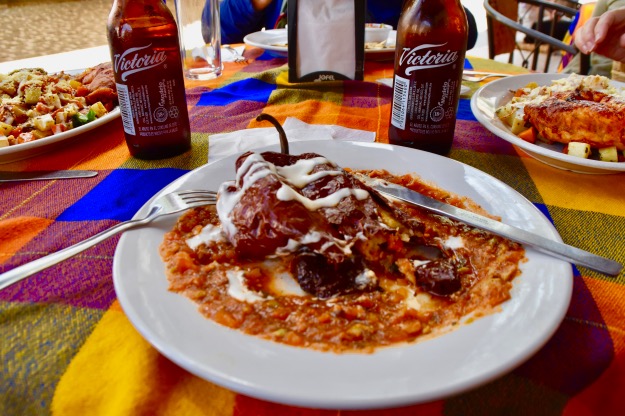 Smoked Pepper Stuffed with Cornbread
Smoked Pepper Stuffed with Cornbread
Quite full and content, we caught the sound of music coming from the plaza and went over to investigate, where we found one of the most interesting things we saw in all of Mexico. It was a street performance by a group of viejitos.
A viejito is an old man and in a tradition started by Tarascan Indigenous people, young men and children dress up as old men and sing and dance for the amusement of their neighbours. Of course, any donations made are always welcome. This tiny viejito was not more than three years old and the star of the show.
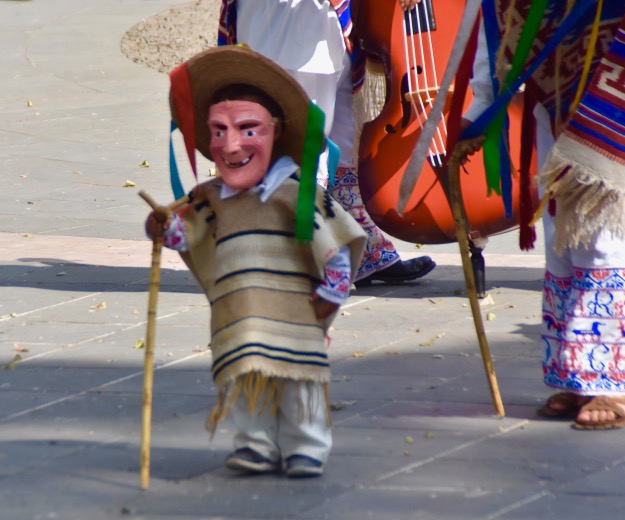 Tiny Viejitos Dancer
Tiny Viejitos Dancer
This is a video of part of the performance.
Watching the viejitos in the Plaza Grande in Patzcuaro was a really fitting way to end or brief visit to the state of Michoacan. Next we are off to our final city of this great adventure, Guadalajara. See you there.
Many thanks again to Dale of the Maritime Explorer for his excellent insight and photos.
Have you thought about travelling to Central America, want to avoid resorts and learn more about the culture? Check out our Mexico sightseeing tours!
If you want to read more stories about Mexico tours, check out our other Mexico travel blog posts.